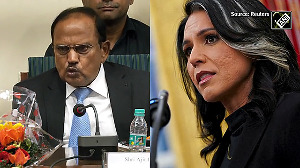China and India are not in a state of equilibrium yet. Each fears from the other a threat. Each is engaged in gauging the depth of this threat and devising ways to neutralise it.
The story starts from the time of India's independence. A letter from Prime Minister Jawaharlal Nehru to India's UN representative soon after India became independent had clarified that India's efforts to seat China at the UN were aimed at getting China into the comity of nations so that it would act responsibly towards others. The policy was in recognition of the reality that China with its relative strengths vis-à-vis India could prove dangerous unless constrained by an internationally accepted code of conduct in state relations.
How genuine were Nehru's apprehensions became evident when in the late 1950s it was discovered that China had built a road through Ladakh's Aksai Chin, linking Tibet with Xinjiang. Such encroachments could take place anywhere on the Indo-China border, as the entire border was undemarcated.
Nehru's policy of Panchshila was another instrument for restraining China. In 1954 India had recognised Tibet as a part of China but when Dalai Lama took refuge in India, China's suspicions about India's motivations were aroused. China now saw India as inimical to its interests in Tibet.
The 1962 Indo-China war was the result of an exaggerated threat perception on China's part. The war confirmed the Indian impression that China was an irresponsible and aggressive power that needed to be checkmated through an appropriately devised strategy.
Following this war India, in a policy reversal, accepted military and intelligence support from the US. The nature of the intelligence support aggravated Chinese reservations about Indian motives since it could be interpreted as an effort to reopen the Tibet question. Apprehending a long term Indo-US strategic linkage, China developed Pakistan as a counter to India. The war had other repercussions. It strengthened the Indian resolve to develop the nuclear dimension.
It took a long time for mutual suspicions to ease. In the meantime, China's ally Pakistan had fought two wars with India in 1965 and 1971 and had lost heavily. Because of interlocking interests in the international area, China was unable to provide any field assistance to Pakistan much to the latter's disappointment. India's relationship with the Soviet Union had blossomed to the point where the Soviet reaction to the targeting of India had to be taken into account by any possible dversary.
1972 to 1988 was a period of reassessments by both countries of perceptions of mutual threat. While the existence of a troubled border could not be wished away, both countries signalled to each other that they should move on in their bilateral relationship. While the Dalai Lama's presence in India and his activities in Europe and the US remained an irritant, China was willing to accept that India, with its traditions of nonviolence dating back to the times of Gautam Buddha, did not intend to harm China in any way.
A great deal of groundwork took place, paving the way for the historic meeting in 1988 between then Indian Prime Minister Rajiv Gandhi and Deng Xiao Ping. Their handshake was probably the longest recorded in recent times between any two leaders.
The significance of the Gandhi-Deng meeting lies in the fact that it marked a new strategic appraisal of India on China's part. The Tibet factor was somewhat downgraded as India was not considered dangerous per se to Chinese interests. An agreement followed in 1993 on maintenance of peace and tranquility along the Line of Actual Control, LAC.
In 1996 came a followup agreement on confidence building measures. Both these represented a major forward movement even if the movement was slow and limited in nature. It should also be noted that the borders have remained tranquil after 1962 except for some minor tensions in one sector in 1986. Maps were exchanged in the middle sector of Uttar Pradesh and Uttaranchal but they dealt with the location of the LAC, not the borders.
At the geopolitical level, the Chinese anxieties are different, concomitantly colouring the Chinese view of India. The principal worry becomes whether India will allow itself to be an instrument to containment efforts of various powers that China thinks want to encircle it.
Geopolitically, China feels threatened at two planes. After 9/11, US presence around China has shown remarkable increments, with the US exploring widened strategic linkages with the countries in the region. China does not rule out a US-India tieup. At the other plane, China apprehends an onslaught by US and Western powers to promote dissent and separatism inside China for enforcing changes in its political and social systems.
The second challenge will be combated through internal cohesion and stability. Therefore, the Communist Party of China cannot be expected to relinquish its domination over governance even as it liberalises to give a new profile to its business community and promotes decentralisation of its economy. The CPC will maintain its primacy well into the foreseeable future. Its control of the People's Liberation Army will ensure this.
In the geopolitical context, certain legitimate steps being taken by India could be misunderstood by China. India's search for new economic and strategic engagements with the wider Asian region could be interpreted by it as an effort to challenge its influence in these regions. The Indian efforts to maximise capabilities could be seen as another dimension of the challenge from India for parity and equality of status. Such doubts get deepened in the background of the 1998 nuclear tests of India when an impression was allowed to be created that the tests were to thwart the dangers from China.
Such a perspective produces a desire to keep India off balance. Consequently, China has tried to build close relations with all of India's neighbours. Pakistan has been developed to be its Israel. China is investing in bases and port facilities in neighbouring regions. The 1975 Sikkim merger with India remains yet to be blessed.
The anticipated geopolitical threat from the US, Japan, etc has led to a furious pace in military and economic modernisation. From being just a continental power concerned with borders, China is seeking to become a maritime and nuclear power with capabilities for quick power projection.
The threat scenario for China is thus much larger.
In this scenario India occupies only a miniscule part. There is much to be gained by a closer relationship between the two. Trade can grow by leaps and bounds as recent trends indicate. Other economic dividends such as regional cooperation, free trade zones can follow. If China can be convinced that Indian policies will be truly governed by enlightened nonalignment, the Chinese proclivity to create counters against India's neighbourhood may diminish. On Kashmir, China has already moved away from self-determination to a policy of respect for the Line of Control. There is a challenge here for Indian policymakers, on how to manage the Chinese sense of threats and isolation, even ignoring to some extent the China-Pakistan linkages.
Prime Minister Atal Bihari Vajpayee's visit offers such an opportunity. If the Chinese fear the outside world, they need to be educated and convinced that India does not belong to the dreaded circle.
A K Verma is a former chief of RAW






 © 2025
© 2025